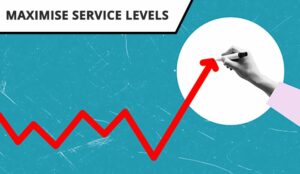Maximizing service levels is crucial for maintaining efficiency and customer satisfaction in contact centres. High service levels ensure that customer inquiries are addressed promptly, reducing wait times, minimizing call abandonment, and fostering a more positive customer experience.
Our panel of experts shares their favourite strategies for enhancing service levels and consistently meet targets in the contact centre.
How to Improve Service Level in Your Contact Centre
1. Rethink Your Service Level Targets and Advisor Groupings
When it comes to service level, many contact centres gravitate towards the standard “80% of calls answered within 20 seconds” metric. It is, after all, the industry’s traditional target.
Yet every extra percentage or second in service level targets tends to carry an exponential increase in the FTE required and doesn’t necessarily yield any significant customer experience benefits.
Instead, it’s more beneficial to analyse what actually works for your customers and to have a level that balances customer experience and operational efficiency.

Craig Farley
For example, it’s important to have a big enough pool of advisors to answer your customers’ contacts without them having to queue too long. This is one of those times when bigger really is better, as the more agents you have in one pool that can answer a particular call type, the better.
However, this doesn’t mean massively overstaffing, but rather one pool of 20 agents will deliver far better service level efficiencies than two pools of ten.
So, try to avoid splitting your call types into too many specialist groups, unless required from a training or reporting aspect, as this will reduce service levels.
With thanks to Craig Farley at IP Integration
2. Perfect Your Real-Time Management Strategy
There are various factors that can contribute to a decline in service levels. If the contact centre is not adequately staffed for spikes in demand, or advisors are attending training sessions during known peak times, this will impact service levels.
Unexpected influxes of calls can also catch contact centres off guard, and even if call volumes are forecast and you have plenty of advisors available, high AHT can push service levels down.
Real-time monitoring prevents these issues and can help to improve service level.

Mark Armstrong
By having a real-time comparison of forecast versus actual, the root causes of problems are easily identified. This comparison, at 15- or 30-minute intervals, makes it easy to see whether the variance is in the number of agents, their availability, call volume or AHT.
Having these instantly actionable metrics enables contact centres to get around problems before they impact service levels and frustrate customers.
Thanks to Mark Armstrong at Genesys
3. Confront the Attrition Problem
Reducing your attrition rates within the contact centre is an important factor in helping you improve your service levels.
High attrition rates mean that you’re constantly bringing in new advisors, who will generally have worse rates of First Contact Resolution (FCR) and longer handle times – until they reach full competency. This repeating cycle makes it difficult to maximize service level.
Yet there are many different strategies that we can look to employ in the hopes of reducing attrition. These include:
- Making career progression a priority and discussing in one-to-ones
- Setting clear expectations of the role in recruitment
- Learning from exit interviews and building an action plan
One other key thing to consider is schedule optimization. Scheduling is a core component behind balancing operational efficiency and employee satisfaction, which in turn will reduce your attrition rates and help you maintain your service level targets.
For top tips on how to reduce attrition in your contact centre, read our article: Top 20 Ways to Reduce Attrition Rates in Your Contact Centre
4. Do Your “What If” Scenario Planning
When something unexpected happens and contact volumes skyrocket, it can be very difficult to control your service levels.
If you forecast “what if” scenarios, you will be much better equipped to provide an appropriate response.
However, if you forecast “what if” scenarios, you will be much better equipped to provide an appropriate response.
To help you prepare, “what if” scenario planning is now a feature on some modern workforce management (WFM) systems.
Based on accurate forecasting, individual advisor shifts can be assigned instantly, helping you ensure even your highest peak periods will be covered with additional resources.
Also, it’s well worth planning for scenarios in which you are overstaffed as well as understaffed. This will make sure that you are making best use of idle agents – while still hitting that all important service level.
5. Measure Schedule Adherence in Real Time
Real-time adherence is another feature within many WFM systems which compares planned advisor activity to actual activities taking place throughout the day.
This feature provides real-time views of forecast versus actual call volumes, for example, as well as other key performance indicators such as handle times.

Neil Draycott
This provides leaders with a breakdown of adherence by activity, helping ensure service level targets are being met and, if not, identifying the broken processes or reasons behind why they are not being met.
Also, you can set up alerts on a leader’s desk, to show when an advisor is taking much longer than expected on a call. This allows the leader to offer their support to an advisor, to help them through the potentially difficult call and get things back on track.
With thanks to Neil Draycott at Business Systems
For ways to calculate schedule adherence, read our article: How do I Calculate… Schedule Adherence?
6. Tackle Large Variations in Handling Times
Big variations in handling times make it difficult for workforce planners to create schedules – as some advisors take twice as long to answer the same contact types.
With such a difference in handle times, planning to a service level target become a tricky proposition.
But why are advisor handle times so different? Well, there are a number of reasons, including variations in rapport-building ability, system knowledge and coaching gaps.
Of course, we can’t pressure advisors to lower Average Handling Time (AHT), as that will lead to them picking up behaviours that negatively influence customer service.

Shorit Ghosh
But we can analyse what our top performers, in terms of both AHT and customer satisfaction (CSAT), are doing well and coach that in. This will help to lower AHT variation – allowing us to maximize service level.
Speech analytics is a great tool to help do this, while it can also pinpoint drivers of excessive talk time and silence, both of which present opportunities for process improvement and better advisor training.
Thanks to Shorit Ghosh at Clarabridge
7. Know How to Encourage Advisors to Work Overtime
The best way to maximize service level is to accurately forecast contact volumes and fortunately there are lots of ways to increase forecast accuracy, like:
- Avoiding the assumption that the forecasting software always knows best
- Experimenting with different forecasting methods to find which works best for your specific contact centre
- Improving communication with other departments and understanding how their activity impacts contact volumes
Yet, even if we have good, experienced planners who know all of these best practices, we must realize that achieving 100% forecast accuracy is a far from realistic goal.
Even if we have done all of the necessary planning, we will still – on occasion – be confronted with unplanned absenteeism or unexpected crises.

Neil Titcomb
In such cases, relying on gamification techniques has proven effective in incentivizing staff to come in on Monday mornings, stay committed through rough shifts and work late nights.
Other ideas for encouraging staff to work more overtime include giving overtime workers preferential treatment in booking time off and playing live sport on your wallboards.
The key really is to answer the question: what’s in it for me?
With thanks to Neil Titcomb at Odigo
8. Allow Advisors to Manage Their Own Schedules
By lowering absenteeism, you can better execute your plan to meet your target service level.
One way to lower absenteeism while boosting employee engagement is to give advisors the ability to manage their own schedules. This can be done by introducing intraday self-scheduling technology.
One way to lower absenteeism while boosting employee engagement is to give advisors the ability to manage their own schedules.
Within thresholds set by managers or resource planners, advisors can quickly move break times or lunches and, over time, e-learning and coaching to accommodate sudden domestic emergencies or sickness and minimize stress. This is all while maximizing your service level.
All forms of self-service are great for helping advisors take control of their lives – which is especially important in today’s new home-working environment.
9. Look for Safe, Marginal Gains in Average Handling Time (AHT)
If you audit your call centre with the aim of maximising your service level, you will probably find that you are doing everything well already, so there is no silver bullet to make a big increase.
Look instead for lots of little gains in AHT that can add up. Marginal gains – remember those?

Claire Dutton
To help reduce mistakes and repetitions on calls, make them shorter and increase the availability of staff, managers should walk around the call centre and check that everyone is wearing their headset correctly with the microphone in the right place.
It’s a simple check so there’s no need for expensive new technology to do this. Having the microphone in the right place enables employees’ voices to be heard clearly.
If you have the headsets with clear voice tubes, ensure all the headsets have the voice tubes present and positioned in the right place.
This simple technique will give you clearer calls with less mistakes and repetition, ultimately leading to shorter calls and better staff availability – all for free!
With thanks to Claire Dutton at Poly
10. Value Emotional Well-Being
In times of change, achieving advisor happiness is essential for meeting service levels in the short term and keeping talented staff in the longer term.
Good communication is critical to counteract feelings of isolation and uncertainty. While working remotely replace face-to-face huddles with virtual FaceTime meetings and insert new coaching sessions into saved “commuter” time to keep agents motivated.

Magnus Geverts
Then you can introduce initiatives like “webisodes” to issue regular company updates, communicate best practices, highlight key employees or spotlight new outbound campaigns.
However, when factors like the continuing threat of the pandemic undermine agent confidence and performance, focus on team rather than individual performance.
Promoting collaboration and an enhanced sense of inclusivity and connection makes it a whole lot easier to achieve critical service levels.
Thanks to Magnus Geverts at Calabrio
11. Offload Contacts Through Improved Self-Service
If you are struggling to improve your service level, don’t rush to submit an HR request for more advisors. Instead, look for technology that allows you to reduce agents’ workload by offering self-service, helping your customers help themselves.
Routine, repetitive customer enquiries, like account balances and password resets, can tie up advisor time and impact your service levels.
Let’s face it, all customers want is fast resolution. They don’t really care how they get it – whether it’s from a live advisor or self-service, such as a chatbot or IVR.

Lisa Hotchkiss
The trick with self-service is that you need to make it easy to use. If you don’t, customers will just press 0 to speak to an advisor and you’re back to where you started.
Using conversational AI allows a customer to interact with a chatbot or IVR naturally, like they would when speaking to a human being, eliminating the need for them to input specific terms and endure complex IVR trees.
Just test it thoroughly and over time it will start narrowing down your workload, helping you to better meet service level targets.
With thanks to Lisa Hotchkiss at NICE inContact
12. Give Advisors the Right Tools
Maximizing service levels has become about more than just answering a certain percentage of calls per day. The quality of the customer care and the sound quality of the call itself are equally as important as keeping pace with high volumes of calls.
Giving staff the right devices will improve service levels across the entire contact centre.
For example, a digital headset that can optimize call quality, improve focus and boost productivity – which all help to contribute to contact centres better meeting their service level targets.

Nigel Dunn
Purpose-built software also provides live guidance agent prompts, which ensures that conversations are always crystal clear on every call.
The software capabilities will also allow supervisors and managers to benefit from the analytics data generated on every call. This allows managers to do their job efficiently, making the changes needed to improve service levels while having a rounded view of how the contact centre is performing.
With thanks to Nigel Dunn at Jabra
13. Find Ways to Improve Advisor Productivity
We set targets for service level so that we can answer a certain percentage of calls in a certain amount of time in a measurable period.
How can we hit these service level targets more consistently? Well, sometimes it isn’t enough to simply fill every chair in your contact centre.
To maximize our service level, we can look to increase productivity on an advisor-per-advisor basis, which will immediately impact your bottom line and remove administrative headaches.
We can achieve this by:

Shilpi Guptaat
- Giving advisors the right tools, so they don’t have to switch between multiple platforms in order to solve a customer query
- Embracing omnichannel and self-service solutions, which may include intelligent virtual assistants. These help to remove simple queries that take up lots of time
- Sharing best practice examples of good techniques for efficient service and coaching advisors how to use them for clear and direct conversation – which complements good customer service
Thanks to Shilpi Guptaat at Aspect
14. Investigate New Shift Patterns
There are lots of new ways to schedule contact centre advisors these days, with new techniques including split, plant and pyramid shifts.
Also, your scheduling plans will ideally offer wellness breaks as a great way to help advisors who are under increasing levels of pressure.
Offering these options results in lower absenteeism and reduces turnover – both of which will positively influence your service level.

Aviad Abiri
Another way to do this is to introduce a scheduling capability that provides advisors, who are increasingly on-the-go, with an intuitive mobile user interface (UI) / user experience (UX).
With this, advisors will be easily able to request shift changes and swaps, and then quickly receive a response without needing to contact other agents, their supervisor or workforce manager.
Thanks to Aviad Abiri at NICE
For more insights from our panel of experts into key contact centre metrics, read our articles:
- What’s Next With… Contact Centre Metrics?
- 32 Contact Centre KPIs That You Need to Track (And Why!)
- Which KPIs Do I Need for Contact Centre WFM?
Author: Charlie Mitchell
Reviewed by: Hannah Swankie
Published On: 21st Sep 2020 - Last modified: 17th Sep 2024
Read more about - Hints and Tips, Aviad Abiri, Business Systems, Calabrio, Clarabridge, Craig Farley, Genesys, IP Integration, Jabra, Lisa Hotchkiss, Magnus Geverts, Mark Armstrong, Neil Draycott, Neil Titcomb, NICE, NICE CXone, Nigel Dunn, Odigo, Poly, Service Level, Shorit Ghosh, Workforce Management (WFM)







































